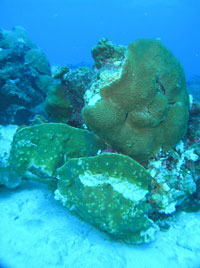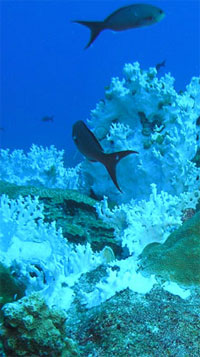
Popular Gulf of Mexico Dive Site
Takes Hit During Hurricane Season
by National Marine Sanctuaries
When Hurricane Rita plowed through the Gulf of Mexico in late September, scientists became worried about potential damage to the Flower Garden Banks National Marine Sanctuary, a popular dive destination and biological hot spot roughly 100 miles off the coast of Texas and Louisiana. With wind speeds of 120 mph, it was estimated that Rita generated waves over the banks of at least 30 feet.
 |
| Coral toppled by storm waves. (Photo: Flower Garden Banks National Marine Sanctuary) |
|
|
Sanctuary biologists with NOAA’s National Marine Sanctuary Program, which manages the sanctuary, waited anxiously for several weeks for seas to calm so they could investigate the damage. An initial survey recently completed documented a number of coral heads that were dislodged, rolled around and broken. Other impacts included extensive damage to a large field of yellow pencil coral and shifting of massive amounts of sand, much of which ended up in large barrel sponges.
“Storm damage is nothing new to the banks,” said G.P. Schmahl, manager of the Flower Garden Banks sanctuary. “Under normal conditions, the reef would spend the next 20 to 50 years repairing itself,” he said. “It’s a natural part of a coral reef’s life cycle.”
 |
| Bleached coral. (Photo: Flower Garden Banks National Marine Sanctuary) |
|
|
However, coinciding with the storm damage is a coral bleaching event that was first noticed in August, but had increased in severity by the time surveys were conducted after Rita passed through. The November survey indicated that up to 40 percent of coral colonies are still being affected by bleaching. Sanctuary biologists say that in their present conditions, corals can last for a while longer, but if the bleaching continues for another month, there could be major losses.
It is unclear if the bleaching is a result of the several hurricanes that have churned through the Gulf during this record breaking hurricane season, but biologists say it is certainly not helping the situation.
The Flower Garden Banks coral reefs have been largely immune to the serious problems facing most coral reefs worldwide due to their offshore location in the Gulf of Mexico. The waters are clear and they are the most northern coral reefs in the continental United States and thus do not experience long periods of hot ocean temperatures like their counterparts in the Caribbean. Above average ocean temperatures have been shown to be a good indicator for coral bleaching.
A follow-up cruise is planned in December.
|










